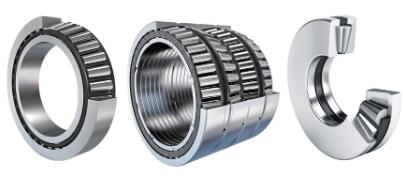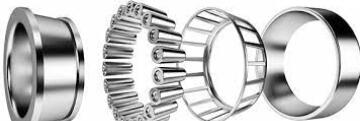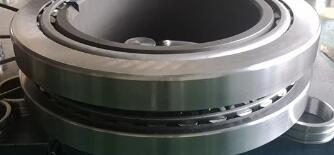A complete guide to Tapered roller thrust bearings in 2023
This guide provides a comprehensive overview of tapered roller thrust bearings in 2023, including an introduction to their design, implementation, and application.
Learn how to choose the right bearing for your project!
In the ever-evolving world of engineering, the need for reliable and efficient parts and components is more important than ever.
Tapered roller thrust bearings are an essential component for most machines and machines, and this guide will provide an overview of the latest advances in this technology in 2023.
Tapered roller thrust bearings are a type of bearing used in many industrial applications.
They are designed to handle thrust loads and are composed of a series of tapered rollers placed in a cage.
They provide high load capacity and excellent axial and radial stiffness.
They are commonly found in gearboxes, printing presses, and robotics.
This year, this guide is your go-to resource for understanding these essential components and how to maximize their efficiency in your projects.
Continue reading to know more about tapered roller thrust bearings below!
Introduction for tapered roller thrust bearings

single direction
Single-direction tapered roller bearings are a special type of bearing designed to handle high axial loads in one direction.
They are made up of a cylindrical roller and a tapered raceway on the outer ring and a tapered raceway on the inner ring.
These bearings are ideal for applications that require high axial load support in one direction with low friction and low maintenance.
They can be used in a variety of industrial applications including conveyors, machine tools, and pumps.
Components of tapered roller thrust bearings

one shaft washer,
The one-shaft washer of tapered roller thrust bearings is a component used to limit the axial movement of the bearing.
It is a washer-shaped component with a tapered outer diameter that is slightly larger than the outer diameter of the bearing and is usually made of steel.
The one-shaft washer is installed between two bearing rings and prevents the bearing rings from being forced apart, thus limiting the axial movement of the bearing.
It also helps absorb axial thrust loads that may be generated by the bearing during operation.
The one-shaft washer is available in various sizes and thicknesses and is designed to fit specific tapered roller thrust bearing models.
one housing washer
The housing washer is a flat, round piece of metal that serves as the outer housing for the bearing.
It is typically made of steel and coated with a rust-resistant finish.
It has a tapered bore, which allows for the tapered roller to move freely within the housing washer.
The housing washer also serves to keep the bearing in place within the assembly.
The tapered roller is a cylindrical roller with conical surfaces that allow the roller to move relative to the housing washer.
This motion helps to reduce friction, resulting in better performance and longer bearing life.
one cage with tapered rolling elements.
Tapered roller thrust bearings with one cage are designed to carry thrust loads in one direction.
They consist of a single row of tapered rolling elements, typically cylindrical rollers, arranged in a cage.
The one cage with tapered rolling elements of the tapered roller thrust bearing consists of a cage, which is a metal ring with a series of evenly spaced and equally sized pockets or slots that contain the rolling elements.
The pockets are arranged in a helical pattern, which allows the rollers to roll smoothly and evenly against the bearing surface.
The cage serves to retain the rollers in their correct positions and guide them as they rotate.
The cage also minimizes friction and noise and helps to reduce vibration.
Benefit of tapered roller thrust bearings

Absorption of very high axial forces
Tapered roller thrust bearings are designed to absorb very high axial forces.
They can do this through their unique design which includes tapered rollers and large contact areas between the rollers and raceways.
The tapered rollers allow for a gradual increase in the contact area, which results in a gradual increase in the bearing’s ability to absorb very high axial forces.
The large contact area between the rollers and raceways allows for the transmission of high axial forces without causing excessive wear on the bearing components.
This design also helps to reduce the risk of failure due to overload, as the tapered rollers will redistribute the load along the contact area to reduce the stress on any one component.
Absorption of high radial forces
Tapered roller thrust bearings are designed to absorb very high radial forces.
They are typically mounted with the tapered rollers facing inward, forming a cone shape with the rollers in contact.
This arrangement allows the bearing to transfer loads from the inner raceway to the outer raceway, while also absorbing radial forces.
The tapered rollers also help to minimize friction and vibration, providing a smoother operation.
The rollers are also designed to rotate freely and reduce the amount of heat generated by the bearing.
The tapered roller thrust bearing can absorb very high radial forces due to its design and construction.
The rollers are made from high-quality materials such as steel, which is highly resistant to wear and tear.
The bearing is also designed with a lubrication system, which helps to reduce friction and maintain a smooth operation.
Low friction
Tapered roller thrust bearings are designed with low friction in mind.
This means that they have a low coefficient of friction, meaning that the components that the bearing is connected to will have less resistance when they are in motion.
This is beneficial because it helps to reduce wear and tear on the parts, leading to a longer lifespan.
The low friction also helps to reduce energy consumption, as the parts do not need to expend as much energy to move.
Additionally, the reduced friction can help reduce noise levels when the bearing is in use.
Long service life
Tapered roller thrust bearings have a long service life due to their design.
The tapered rollers are evenly spaced and contact the raceways at a constant angle, which reduces friction and wear on the bearing components.
The bearing is also designed with a large number of rollers, which helps to spread the load over a larger surface area, reducing the risk of premature wear.
Additionally, the bearing components are hardened and designed to resist wear, further increasing the service life of the bearing.
High load-carrying capacity
Tapered roller thrust bearings can carry high axial loads in one direction.
This means that these bearings are ideal for applications that require high load-carrying capacity.
They are capable of carrying higher loads than other types of thrust bearings, such as cylindrical or flat thrust bearings.
Tapered roller thrust bearings are also capable of handling very large axial thrust loads in both directions.
This makes them suitable for applications that require heavy-duty thrust-bearing performance.
Tapered roller thrust bearings are also able to handle large amounts of radial loads, making them a versatile and reliable choice for many applications.
Application of tapered roller thrust bearings
Material Handling
Tapered roller thrust bearings are used in material handling applications to support radial and axial loads.
They are designed to have a high load capacity and can handle heavy radial and axial loads.
These bearings have an inner and outer raceway, with tapered rollers in between that provide rolling contact between the two surfaces.
This rolling contact reduces friction and wear, which is important for material handling applications where efficiency is paramount.
They are ideal for applications such as conveyor systems, hoists, and cranes, as well as in industrial machinery, construction, and mining equipment.
Tapered roller thrust bearings are designed to reduce friction and vibration while providing a stable platform for operation.
The tapered roller design helps to reduce wear on the bearing while providing excellent radial and axial load support.
These bearings are ideal in material handling applications due to their ability to handle heavy radial and axial loads while providing a stable platform for operation.
Additionally, the bearings are self-aligning, so they can be easily adjusted to accommodate any slight misalignments that may occur during operation.
Industrial transmissions
Tapered roller thrust bearings are used in a variety of industrial transmissions, including gearboxes, speed reducers, and differential shaft drives.
These components are ideal for applications where high axial loads are present, such as those found in transmissions.
They provide high levels of stiffness and strength while also having the ability to take up large amounts of axial misalignment.
Due to their ability to handle high loads, tapered roller thrust bearings are often found in the transmissions of wind turbines, conveyor systems, and various types of machine tools.
The tapered rollers are designed to provide uniform load distribution and smooth operation, while their tapered shape allows the rollers to deflect and absorb shock loads.
This makes them ideal for industrial applications that require high load capacity, smooth operation, and misalignment tolerance.
The design of the bearings allows them to provide a high level of stability and reliability, even in the harshest of environments.
Tapered roller thrust bearings are also resistant to wear and can operate in a wide range of temperatures.
As a result, they are often used in industrial transmissions which require reliable performance under extreme conditions.
Machine tools
Tapered roller thrust bearings are used in many machine tools.
These bearings provide excellent support for the rotating components of machine tools and are used to handle thrust loads and radial loads.
They are generally composed of two tapered rollers and a cage that keeps them in place.
Tapered roller thrust bearings typically have higher load ratings and longer life than standard cylindrical thrust bearings, making them ideal for machine tools that work with high loads and require long-term operation.
The rollers are tapered to reduce friction, provide a smoother motion, increased stiffness and accuracy, and improve the performance of machine tools.
The application of these bearings helps to reduce wear and tear on the machine tool components, increasing their life span and reducing maintenance costs.
Tapered roller thrust bearings are typically used in combination with other types of bearings for increased strength and rigidity.
They are also used in spindles to increase accuracy and speed.
Additionally, tapered roller thrust bearings have a low moment of inertia, reducing the power requirement of the machine tool and allowing for higher torque capacity.
The tapered roller design also facilitates easier installation and maintenance, reducing downtime and increasing overall efficiency.
Trucks, trailers, and buses
Tapered roller thrust bearings are used in trucks, trailers, and buses to provide stability and smooth operation of the vehicle.
Tapered roller thrust bearings are designed to withstand high axial loads, as well as radial loads.
They also feature a unique design that allows them to self-align, enabling them to maintain a more uniform contact between the bearing and shaft.
This ensures a smoother operation, greater reliability, and longer life of the bearing.
Tapered roller thrust bearings also feature low friction and high shock resistance, making them ideal for use in trucks, trailers, and buses.
They are typically used in steering knuckles, crankshafts, and gearboxes.
Tapered roller thrust bearings can offer better load-carrying capacity than other types of thrust bearings, making them a popular choice for these applications.
Summarize of tapered roller thrust bearings
Tapered roller thrust bearings are used for heavy axial loads and radial loads in a single direction.
They consist of two hardened and ground-tapered roller races, separated by a spacer, and a cage that holds the rollers in place.
The tapered rollers are positioned perpendicular to the thrust direction and help to reduce friction and provide support.
The cages are typically made from steel, brass, or plastic, depending on their intended application.
Tapered roller thrust bearings can be used in a variety of applications, from automotive transmissions to conveyor systems.
They are a cost-effective way to reduce friction and extend the life of an application.
Conclusion
With advances in engineering and manufacturing techniques, tapered roller thrust bearings have become an essential component in many industries.
Their reliability, accuracy, and cost-effectiveness make them a top choice for industrial applications.





